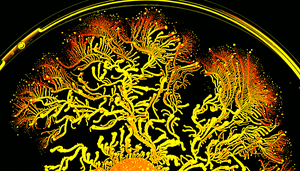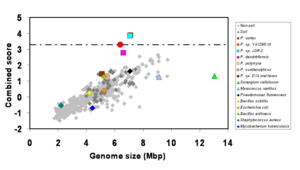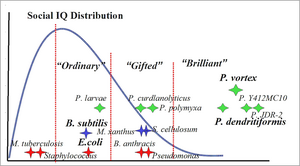Social IQ score of bacteria
It has been suggested that this article be merged into Eshel Ben-Jacob. (Discuss) Proposed since February 2018. |
This article's tone or style may not reflect the encyclopedic tone used on Wikipedia. (September 2011) (Learn how and when to remove this template message) |

Social IQ score of bacteria is a recently proposed quantitative score[1] devised as a comparative genomic tool to assess the genome potential of bacteria to conduct successful cooperative and adaptable behaviors (or social behaviors) in complex adverse environments.
The need of the new measure follows the current realization that bacteria are smart creatures that can conduct intricate social life in large and complex colonies using sophisticated chemical communication.[2][3] Researchers have only recently begun to decode how they can rapidly adapt to changes in the environment, distribute tasks, "learn from experience", prepare for the future and make decisions.[4][5][6] While the number of bacteria in a colony (Figure 1) can be more than 100 times the number of people on Earth, bacteria are able to make sure they are all synchronized by sharing simple chemical messages.
Social-IQ of humans[edit]
The IQ score of humans is supposed to reflect their mathematical, analytical and logical capabilities.[7][8] Emotional and social skills may be equally important, and individuals with extremely high IQ may have poor social skills. Social intelligence is an individual's capacity to perceive and understand the environment – from local surroundings to what is happening in the world – and to respond to that understanding in a personally and socially effective manner. In view of that, a Social-IQ score has been developed in a manner similar to the familiar IQ, where the average Social-IQ is defined as 100 points; socially gifted individuals have Social-IQ of one standard deviation above normal and those with brilliant social skills have Social-IQ of two standard deviations above normal.
Bacteria's Social-IQ[edit]


The score is based on the number of genes which afford bacteria abilities to communicate and process environmental information (Two-component system and transcription factor genes), to make decisions and to synthesize offensive (toxic) and defensive (neutralizing) agents as needed during chemical warfare with other microorganisms. Three bacteria species stand out with significantly high Social-IQ score among all sequenced bacteria – over 3 standard deviations higher than average, indicating a capacity for exceptionally brilliant social skills (Figure 2). Notably, all these species belong to the same bacteria genus – the Paenibacillus genus that was identified as a new genus only in 1993.[9]
Harnessing bacterial intelligence[edit]
Information about bacterial IQ can be applied in green agriculture or biological control, where bacteria’s advanced offense strategies and the toxic agents they synthesize are used to fight harmful bacteria and fungi and even higher organisms. The Paenibacillus genus bacteria, to which the three smartest bacteria belong (Figure 3), are known to be a rich source for industrial, agricultural and medical applications.
Bacteria are often found in soil and live in harmony with a plant’s roots –– a process called symbiosis. The environment down there is very competitive, and bacteria help the plant roots access nutrients; in exchange, the bacteria consume sugar from the roots. Both help each other.
For that reason, bacteria are now applied in agriculture to increase the productivity of plants and make them stronger against pests and disease. The Social-IQ score could help developers screen which bacteria might work best for each task.
See also[edit]
- Eshel Ben-Jacob
- Paenibacillus
- Paenibacillus dendritiformis
- Paenibacillus vortex
- Microbial intelligence
References[edit]
- ↑ Sirota-Madi A, Olender T, Helman Y, et al. Genome sequence of the pattern forming Paenibacillus vortex bacterium reveals potential for thriving in complex environments. BMC Genomics.11:710.
- ↑ Ben-Jacob E, Cohen I, Gutnick DL. Cooperative organization of bacterial colonies: from genotype to morphotype. Annu Rev Microbiol. 1998;52:779–806.
- ↑ Ben-Jacob E, Shochet O, Tenenbaum A, Avidan O. Evolution of complexity during growth of bacterial colonies. Paper presented at: NATO Advanced Research Workshop, 1995; Santa Fe, USA.
- ↑ Ben-Jacob E. Bacterial self-organization: co-enhancement of complexification and adaptability in a dynamic environment. Phil. Trans. R. Soc. Lond. A. 2003;361(1807):1283–1312.
- ↑ Ben-Jacob E, Becker I, Shapira Y, Levine H. Bacterial linguistic communication and social intelligence. Trends Microbiol. Aug 2004;12(8):366–372.
- ↑ Dwyer DJ, Kohanski MA, Collins JJ. Networking opportunities for bacteria. Cell. Dec 26 2008;135(7):1153–1156.
- ↑ Gottfredson LS. Intelligence: is it the epidemiologists' elusive "fundamental cause" of social class inequalities in health? J Pers Soc Psychol. Jan 2004;86(1):174-199.
- ↑ Judge TA, Colbert AE, Ilies R. Intelligence and leadership: a quantitative review and test of theoretical propositions. J Appl Psychol. Jun 2004;89(3):542-552.
- ↑ Ash C, Priest FG, Collins MD. Molecular identification of rRNA group 3 bacilli (Ash, Farrow, Wallbanks and Collins) using a PCR probe test. Proposal for the creation of a new genus Paenibacillus. Antonie Van Leeuwenhoek. 1993;64(3-4):253–260.
External links[edit]
- Prof. Eshel Ben-Jacob's Home Page
- Realizing Social Intelligence of Bacteria
- "Learning from bacteria about social networks" Lecture presented at Google headquarters
- P. vortex genome sequence
- Bacterial self–organization: co–enhancement of complexification and adaptability in a dynamic environment
- Bacterial linguistic communication and social intelligence
- Swarming and complex pattern formation in Paenibacillus vortex studied by imaging and tracking cells
- The genius of bacteria
- Gambling on Bacteria
- The tree of Life: IQ Test for Bacteria
This article "Social IQ score of bacteria" is from Wikipedia. The list of its authors can be seen in its historical and/or the page Edithistory:Social IQ score of bacteria. Articles copied from Draft Namespace on Wikipedia could be seen on the Draft Namespace of Wikipedia and not main one.
